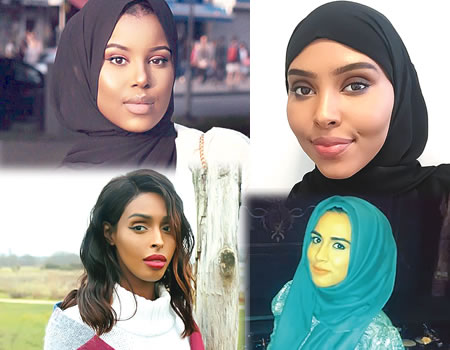The brainchild of this movement is a resident of New York, United States, Nazma Khan, who came up with the idea as a means to foster religious tolerance and understanding by inviting women (non-Hijabi Muslims/non-Muslims) to experience the hijab for one day.
For many people, the hijab is a symbol of oppression and segregation. By opening up new pathways to understanding, Nazma hopes to counteract some of the controversies surrounding why Muslim women choose to wear the hijab.
Here three women tell a women’s magazine, Glamour UK, why they choose to wear the hijab, and one woman discusses why she opts not to.
Asha Hussein, 25, social media influencer and blogger
“I was 17 when I made the decision that completely changed my life not just as a Muslim, but as a woman. I decided to wear the hijab.
“Like many women who wear the hijab, it was to become more spiritually connected to my religion, to actively practise Islam and not just to tick the Muslim box on a form.
“The first thing I noticed was that people listened more to what I was saying. I was coming to people as a blank canvas and that, as a woman, is both empowering and liberating. It’s addictive. I am not my hair, I am not my beauty, I am not my body. I am me.
“As a social media influencer, I feel attitudes towards hijab-wearing women can be polarising. You’re either portrayed as an extremist, ISIS sympathiser or an extremely oppressed woman – I’m none of those things. In reality, the only thing extreme about me is how late I leave it to return books to the library.
“My mother, as a British woman, should never have to feel afraid when I leave my home. Hijabis should be admired for holding their heads up high and rocking their hijab every day, without fear.”
Aya Bdaiwi, 27, Interfaith Coordinator and Project Manager at Faiths Forum for London
“At 19 years old, I made the choice to wear the hijab and it empowered me, because it meant I had the power to choose how I presented myself to the world.
“The first day I wore my hijab in public, I was paranoid about how people perceived me. At the time, I was pursuing a career in law and I wondered if my headscarf would be a barrier. But instead, I became more aware of how I was coming across to people and my personality shone through. While I take pride in my appearance, it’s important that I am judged on my personality and mind.
“We are all aware there are a small group of individuals who have twisted Islam to cause fear and division between people. Muslims as a whole are now being judged by the actions of a few people. There’s no denying that there are negative connotations of the hijab everywhere we look today, but this has only spurred me on to make my own choices and not be affected by the judgements of others.
“I’ve learned quickly that you can never please everyone, and if we sought approval from the whole world, you just wouldn’t get anywhere, so I made the choice to please myself and I continued to wear my hijab on a daily basis.”
Khadija Mahamud, 25, digital content creator
“To me, the hijab is more than just a piece of cloth; it’s a symbol of my faith that represents a part of me to the world.
“I started wearing the hijab full-time when I was 15. I was fortunate enough that my mum taught me about the reasons for wearing it and she encouraged me to research its importance. It’s never enough of a reason to do something just because someone else tells you to. In short, it’s because of this that I was able to see the beauty of, and essentially the empowerment of, choosing to cover up.
“In a world where women are often sexualised, there’s something extremely powerful about knowing people won’t judge you based on what you’re wearing.
“People often assume there are limitations to wearing the hijab. For me, it does the opposite; it allows me to be unapologetically myself both as a feminist and as a Muslim woman.
“The media fuels the way people perceive Muslim women; good and bad. We’re either breaking news because we’re breaking boundaries or, somehow, we need to be saved. It seems as though it’s time to accept, Muslim women aren’t so different from other women.”
Muna Jama, 27, former Miss Universe contestant, a model and humanitarian campaigner
“Throughout my career, I have used Islam to guide me but have chosen not to wear the hijab. Instead, I’ve embraced faith through my conversations, my behaviour and the way I dress.
“I showed my own version of modesty when I competed in Miss Universe without wearing a bikini and, instead, was the first woman to wear a kaftan. There were things about Miss Universe that didn’t suit me as a person and I chose to take a stand, so I could make a difference.
“When the media focuses so much on those who wear the hijab, they can forget the diversity of thought among Muslim women. I love wearing a headscarf on certain days and, at other times, practise my modesty entirely differently. That may be wearing a kaftan, owning the catwalk at Modest Fashion Weeks around the world or simply by being a considerate and compassionate person.
“True beauty is defined by our behaviour towards one another and should not be measured by what we wear. The hijab is a wonderful way to practise the Islamic faith but not the only way.
WATCH TOP VIDEOS FROM NIGERIAN TRIBUNE TV
- Relationship Hangout: Public vs Private Proposals – Which Truly Wins in Love?
- “No” Is a Complete Sentence: Why You Should Stop Feeling Guilty
- Relationship Hangout: Friendship Talk 2025 – How to Be a Good Friend & Big Questions on Friendship
- Police Overpower Armed Robbers in Ibadan After Fierce Struggle






